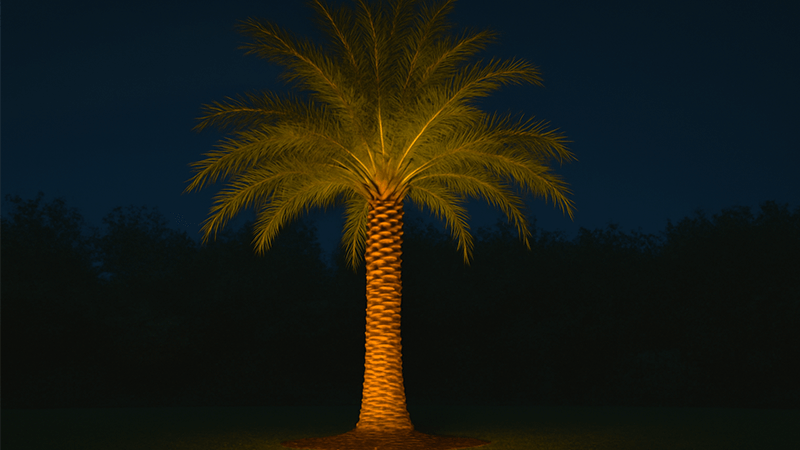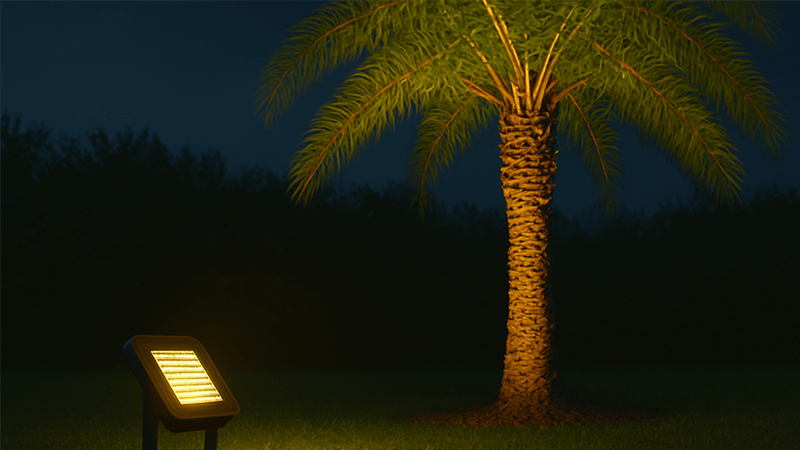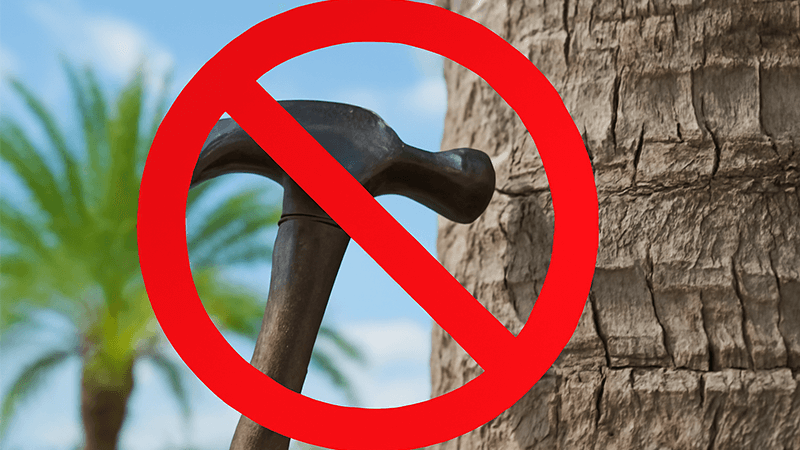Struggling to light up your beautiful palm trees without harming them? You want that stunning resort look, but fear that nails and screws will cause permanent damage.
The best way to light a palm tree is not to put lights on it, but to light it from the ground up. Using methods like uplighting with LED spotlights avoids damaging the trunk while beautifully illuminating its texture and fronds, creating a dramatic and elegant effect.

I’ve spent my entire career in the lighting industry, from working on the factory floor to founding my own company. A question I hear often from clients, especially those in places like the UAE where palms define the landscape, revolves around this very topic. The idea of not putting lights directly on a palm tree isn’t about avoiding lighting it altogether. In fact, it’s the opposite. It’s about creating a breathtaking effect in a way that is smart, sustainable, and respects the tree itself. We’ve learned that the most spectacular results come from techniques that protect the tree’s health. Let’s explore how to achieve that perfect look without causing any harm.
What kind of lights do you put on palm trees?
You see countless options for outdoor lights. Spotlights, string lights, well lights. It’s confusing to know which type will create a professional look without being a hassle or hurting the tree.
The most effective and safest lights for palm trees are ground-installed LED uplights, such as spotlights or in-ground well lights. These fixtures are placed away from the base and aimed upward, highlighting the trunk and canopy without physically attaching anything to the tree itself.

When I work with purchasing managers like Shaz, who need reliable and high-quality solutions for large projects, the conversation always turns to durability and effect. The goal is to make a powerful visual statement that lasts. Wrapping lights around the trunk can look festive for a short time, but it’s not a professional, long-term solution. It can restrict the tree’s growth and create maintenance headaches. The professional approach is all about strategic placement from the ground. This method not only looks more elegant but also protects the client’s investment in both the landscaping and the lighting system.
Why LED Uplights are the Professional’s Choice
Modern landscape lighting almost exclusively uses LED technology for good reason. For one, LEDs produce very little heat compared to old halogen bulbs. Placing a hot light source too close to a tree trunk can stress the bark and harm the tree over time. LEDs run cool, making them the safest option. They are also incredibly energy-efficient, which is a major factor in large-scale commercial projects where dozens or even hundreds of trees are being lit. Lower energy consumption means lower operational costs. Finally, their long lifespan means less maintenance. No one wants to be replacing bulbs constantly, especially in a commercial setting.
Choosing the Right Fixture for the Job
Not all uplights are the same. The specific fixture you choose depends on the tree’s size and the desired effect.
| Fixture Type |
Best For |
Key Advantages |
| LED Spotlights |
Tall, slender trunks and specific fronds |
Highly adjustable; can be aimed precisely to create dramatic shadows and highlight texture. |
| In-Ground Well Lights |
High-traffic areas, clean aesthetics |
Sit flush with the ground, preventing trip hazards; offers a seamless, built-in look. |
| LED Floodlights |
Shorter palms with wide canopies |
Casts a broad wash of light, illuminating the entire canopy evenly for a full, lush look. |
For a tall, majestic Royal Palm, I’d recommend a narrow-beam spotlight to shoot a column of light straight up the trunk. For a shorter, wider Canary Island Date Palm, a floodlight with a wider beam angle would be better to showcase its full, dense crown.
Do palm trees need light?
You invest in high-quality landscaping, and you want to know if you’re helping or hurting it. Does adding artificial light at night actually benefit the palm tree’s health in any way?
No, palm trees do not need artificial light at night to survive or thrive. They require sunlight for photosynthesis during the day. Nighttime lighting is purely for human enjoyment, enhancing aesthetics, safety, and ambiance.

From a purely biological standpoint, plants have evolved over millions of years to a cycle of daylight and darkness. Sunlight is the energy source that fuels their growth through a process called photosynthesis. At night, they enter a respiration phase, which is a different but equally important part of their life cycle. Adding artificial light at night doesn’t provide any horticultural benefit. In fact, some studies suggest that constant, intense artificial light can disrupt a plant’s natural cycles. So, when we specify lighting for landscapes, our purpose is entirely human-centric. It’s about transforming a dark space into a beautiful and usable one.
Sunlight for Survival vs. Artificial Light for Style
It’s crucial to separate what a plant needs from what a designer wants.
- Sunlight (Need): Provides the full spectrum of light necessary for photosynthesis. This is how the tree creates food and grows. The duration and intensity of sunlight dictate the health of the palm.
- Artificial Light (Want): Used to create visual effects. We use it to highlight the rough texture of the trunk, the graceful shape of the fronds, and the overall silhouette of the tree against the night sky. It’s an artistic tool.
I once consulted on a project for a luxury hotel where the architect was concerned about the "health" impact of the lights on their prized palm trees. I explained that by using low-wattage, directed LED uplighting, we are bathing the tree in a gentle glow, not blasting it with the kind of energy it gets from the sun. Our goal is to "paint" with light, not to try and replicate daylight. This reassured him that our lighting plan was about aesthetics and would not interfere with the trees’ natural processes.
What not to do with a palm tree?
You want to decorate your palm trees for a special event or holiday. It seems easy to just wrap some lights around the trunk or nail a fixture to it, but you worry about the long-term consequences.
Never puncture the trunk of a palm tree with nails, screws, or staples. Palms are monocots, and unlike traditional trees, they cannot heal their vascular tissue. Wounds create permanent scars and open pathways for fatal diseases and insect infestations.

This is probably the single most important piece of advice I can give. I have seen beautiful, mature palm trees, worth thousands of dollars, slowly die because someone decided to nail Christmas lights to them. It seems harmless, but it’s a critical mistake. Trees like oaks and maples have a cambium layer that can grow over and heal wounds. Palm trees don’t. Their vascular system, which transports water and nutrients, is scattered throughout the trunk. When you drive a nail into it, you are severing those vital pathways forever.
The Anatomy of a Fatal Mistake
Understanding why this is so bad requires a little bit of plant science.
- Vascular Bundles: Think of these as the veins and arteries of the palm. They run up and down the entire trunk. Puncturing them is like damaging a permanent pipeline; the tree can’t just grow a new one.
- No Healing Bark: A palm’s trunk doesn’t have true bark that can seal over a wound. The hole you create will stay there for the rest of the tree’s life.
- Invitation to Pests and Disease: That open wound is a doorway. Fungal spores, bacteria, and boring insects can easily get inside and start to rot the tree from the inside out. Diseases like Ganoderma butt rot are often introduced this way and are fatal.
Instead of puncturing, use gentle methods if you must attach something temporarily. Use soft, expandable ties or straps that won’t cut into the trunk as it grows. For a permanent lighting solution, however, the only professionally accepted method is to keep all fixtures off the tree and on the ground.
Does a palm tree protect from lightning?
During a storm, you look for shelter. A tall tree seems like a good option, and you wonder if a palm tree, with its unique structure, offers any special protection from a lightning strike.
No, a palm tree does not protect from lightning and is actually a dangerous place to shelter during a storm. Like any tall, isolated object, palm trees are frequently struck by lightning, and their fibrous trunks can explode or catch fire violently when hit.

It’s a common misconception that certain trees are "safer" than others in a thunderstorm. The truth is that lightning is simply looking for the most efficient path to the ground. A tall palm tree, especially one standing alone in an open area or on a golf course, is a prime target. I’ve seen the aftermath of lightning strikes on palm trees during my travels for projects. It’s not a pretty sight. The immense energy and heat from the strike instantly boil the sap inside the trunk.
The Explosive Reality of a Lightning Strike
The result of this rapid boiling is a steam explosion. The force can be powerful enough to split the trunk wide open, shred it into pieces, or even cause the entire top of the tree to blow off. The tree doesn’t offer a safe "cone of protection" at its base. Standing near a palm tree during a storm puts you at risk from several dangers:
- Direct Strike: Lightning could strike the tree and you at the same time.
- Side Flash: The electrical charge can jump from the tree to a nearby object—like a person—on its way to the ground.
- Step Voltage: After the strike, the current spreads out through the ground. If you are standing with your feet apart, the current can travel up one leg and down the other, which can be fatal.
- Flying Debris: As I mentioned, the trunks can explode. This sends sharp, heavy pieces of the tree flying in all directions.
The safest place to be during a thunderstorm is always inside a substantial building or a hard-topped vehicle. Never seek shelter under any tree, including a palm tree.
Conclusion
You can and should light your palm trees. Just do it from the ground up with LED spotlights to protect the tree’s health while creating a stunning, professional nighttime effect.